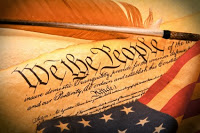 Susan Boskey
Susan Boskey
Activist Post
Note: A reader of this article on another website commented that I had the timeline incorrect regarding the release of the Federalist Papers. When I checked (yet again), I found out h/she was correct. The first one was released one month AFTER the Philadelphia constitutional convention on October 27, 1787 and not before it began. The Federalist goal at that point was to hasten the ratification of their newly signed, second constitution, which was accomplished. Despite this correction, the big picture as represented in the article remains the same. My apologies to the readers for this error.
The problems Americans face today go way back to the founding of the United States. Yet, text-book pride in the Founding Fathers and the inviolate “sacredness” of the Constitution reinforce an impenetrable firewall behind which Americans are blinded. Quick-fixes are not cutting it. We need long-lasting solutions of substance; the root-cause of any problem must be uncovered and analyzed first.
Here are 11 hidden facts about the U.S. Constitution most people probably never learned.
2. The Founding Fathers needed permission from the Congress of the Confederation, “the powers that be” of that day in order to hold the 1787 Philadelphia constitutional convention. On February 21, 1787, the Congress of the Confederation delivered a resolution authorizing a Philadelphia constitutional convention but with an important limitation: “for the sole and express purpose of revising the Articles of Confederation and reporting to Congress and the several legislatures.”
3. Prior to the Philadelphia constitutional convention, Founding Fathers wrote and distributed approximately 85 “Federalist Papers” to extol the virtues of an entirely new, second constitution for the people of America. By doing this, they hoped to reverse the prevailing negative public opinion and increase the public’s confidence in such a plan. To help them, Founding Fathers hid behind a pseudonym when writing their Federalist Papers; each was signed as “Publius,” meaning “friend of the people” (or public).
4. Many of the dissenting voices among early Americans, aka the free inhabitants of the several states, regarded the upcoming Philadelphia constitutional convention as potentially illegal. They well-understood from the Federalist Papers the Federalists goal of creating a new constitution and not simply revising the existing one. Also, if the Federalists did succeed in creating a new constitution, would they then abide by the required unanimous consent of all thirteen states per article thirteen of the Articles of Confederation? These early Americans feared the worst despite how the Federalist Papers waxed elegant assuring that “all power of government was in the people.” In the minds of the free inhabitants, the accomplishment of Federalist goals could unravel the freedoms and liberties they had gained under the Articles of Confederation and won by the American Revolution.
5. Founding Father, George Washington, was aware of and acknowledged the concerns regarding the convention’s potential illegality for the reasons stated, but did not want to discuss it. Instead, he asserted that holding the Philadelphia constitutional convention was worth the risk when he said:
The legality of this Convention I do not mean to discuss, nor how problematical the issue of it may be. That powers are wanting, none can deny. Though what medium they are to be derived, will, like other matters, engage public attention. That which takes the shortest course to obtain them, will, in my opinion, under present circumstances, be found best. Otherwise, like a house on fire, whilst the most regular mode of extinguishing it is contended for, the building is reduced to ashes. — George Washington, in a letter to Secretary of War Henry Knox on February 3, 1787 (reprinted in The Founders’ Constitution)
 6. The Philadelphia constitutional convention was held May into September 1787 with its outcome being that of the Founding Fathers exceeding the authority given them. Instead of only revising the Articles of Confederation they went ahead to create an entirely new constitution. As the prospect of a new constitution had drawn more certain at the convention, arguments began over how to get it ratified. Having so far succeeded at rallying the people to accept this second constitution by going over the heads of the state legislatures and directly to the people via the Federalist Papers, the Founding Fathers were confident they could also get a speedy ratification by the states.
6. The Philadelphia constitutional convention was held May into September 1787 with its outcome being that of the Founding Fathers exceeding the authority given them. Instead of only revising the Articles of Confederation they went ahead to create an entirely new constitution. As the prospect of a new constitution had drawn more certain at the convention, arguments began over how to get it ratified. Having so far succeeded at rallying the people to accept this second constitution by going over the heads of the state legislatures and directly to the people via the Federalist Papers, the Founding Fathers were confident they could also get a speedy ratification by the states.
7. As the Founding Fathers proceeded towards ratification of their new constitution, they denied having had any association with the Congress of the Confederation in utter defiance of the resolution of limited scope granted them. Gouverneur Morris reported that their constitutional convention was “unknown to the Confederation.” Gouverneur Morris said:
Whereas, in case of an appeal to the people of the United States, the supreme authority, the Federal compact may be altered by a majority of them, in like manner as the Constitution of a particular State may be altered by a majority of the people of the State. The amendment moved by Mr. Ellsworth erroneously supposes that we are proceeding on the basis of the Confederation. This Convention is unknown to the Confederation. — Gouverneur Morris, The Records of the Federal Convention of 1787, Volume II
9. This new Constitution, however, per the Articles of Confederation, had not been created by “mutual consent” and therefore could not lawfully replace the Articles of Confederation.
The continental convention in direct violation of the 13th article of confederation, have declared ‘that the ratification of nine states shall be sufficient for the establishment of this constitution, between the states so ratifying the same.’—Thus has the plighted faith of the states been sported with! They had solemnly engaged that the confederation now subsisting should be inviolably preserved by each of them, and the union thereby formed. Should be perpetual, unless the same should be altered by mutual consent. — “The Address and Reasons of Dissent of the Minority of the Convention of Pennsylvania to their Constituents,” December 12, 1787 (emphasis added)
10. The Constitution of the United States, signed September 17, 1787, was deemed ratified June 21, 1788 by only nine states instead of the unanimous ratification of all 13 states required by the Articles of Confederation. Thereafter, a new, centralized U.S. Government was formed, disregarding the original, decentralized American jurisdiction of state legislatures established soon after the American Revolution.
11. Also in June of 1788 at the Virginia Conference, orator and Anti-Federalist, Patrick Henry, exposed the political tactics of propaganda he believed the Federalists had used to win over the public. The Framers had pandered to the people in order to get their way, he said, by convincing the people, that under a new constitution, democracy would mean the government belonged to them. Henry also exposed the deception when Framer’s used the phrase, “We, the people” in the preamble to the Constitution.
Who authorized them to speak the language, ‘We, the people’, instead of ‘We, the states?’ . . . That they exceed their powers is perfectly clear . . . The Federal Convention ought to have amended the old system; for this purpose they were solely delegated; the object of their mission extended to no other consideration. — Patrick Henry, June 4, 1788
 As the saying goes, the rest is history. The Constitution of 1787 and the U.S. Government it formed was an illegitimate (unauthorized) takeover of the original American jurisdiction. One (of many) proofs is that nowhere since have the Articles of Confederation been lawfully repealed in writing. The outcome? Americans who no longer suffer as indentured-servant subjects of the British monarchy now suffer as indentured-servant subjects of a United States beholden to an obscured corporate-banking cartel. It’s just a newfangled monarchy centuries in the making and thanks to the Constitution con.
As the saying goes, the rest is history. The Constitution of 1787 and the U.S. Government it formed was an illegitimate (unauthorized) takeover of the original American jurisdiction. One (of many) proofs is that nowhere since have the Articles of Confederation been lawfully repealed in writing. The outcome? Americans who no longer suffer as indentured-servant subjects of the British monarchy now suffer as indentured-servant subjects of a United States beholden to an obscured corporate-banking cartel. It’s just a newfangled monarchy centuries in the making and thanks to the Constitution con.
The good news is that the first constitution, the Articles of Confederation and Perpetual Union, still stands. Now it’s up to everyone else to confirm if what I have said here is fact or fiction. Please, by all means, prove me wrong. If it is fact, what then might be the personal implications going forward? What might be the next steps for American free inhabitants to take? The prospects are actually very encouraging.
Recently From Susan Boskey:
- “Only Integrity is Going to Count”
- Man-Made Systems – Cui Bono?
- Dictator Rising but Don’t Blame the President
Susan Boskey, freelance researcher and writer, is author of the book, The Quality Life Plan®: 7 Steps to Uncommon Financial Security www.AlternativeFinancialNow.com and more recently helped bring to market the book, Beyond the National Myth: waking up in the land of the free www.nationalmyth.org


The Articles of Confederation IS the legitimate Constitution…..it always will be and it is the only one that exists lawfully. The rest was a usurpation, after usurpation after usurpation…..to bring us to a totalitarian One World Government. The Freemasons knew this quite well. Patrick Henry was a very smart man. And one that I to this day respect like no other. Give me LIBERTY….or GIVE ME DEATH !!!
The original ORGANIC or FIRST Constitution was the Articles of Confederation, NOT the Freemasonic Usurpation.,……that is where we began to go off the rails.
Wrong……what it shows you that that was the plan of the Freemasons all along…..The Articles of Confederation IS our Constitution…. And …if your indoctrination is so correct, then why is there a Marxist in the White House and why did EVERYTHING Cornwallis say come exactly true? Wake up from your slumber……stand for the real Constitution……The ARTICLES of CONFEDERATION
Your opinion is short sighted and naive’ ……
Those who fail to learn the lessons of history are doomed to repeat it.
This author is absolutely correct. And if EVERYONE was made aware at who and how….then what and when would become crystal clear…… DEATH to the IMF, to Rothschild Usury and their criminal Banking cartel…..and re-establishment of morality and of the family….instead of the cultural Marxist brought to us by the best the Freemasons had to offer…Cornwallis ttold us all the truth and if every man and woman who were responsible enough to understand what he said knew what he said we could stand UNITED in truth rather than UNITED IN IGNORANCE.
Can you defend that position with facts ? NO
That is Talmudic law you are referring to that has overtaken the actual rule of law which states IT CAN NOT BE CHANGED….. so Judicial Activists who made a decision 30 years ago….just because they got away with it does not a lawful precedent make.
If you believe that then why do we have a Marxist in the White House and politicians who can break the law at will and never be punished….. naive’ and indoctrinated is what you are…..Our Republic was long overthrown. Its time to get it back